Agricultural Climates
tropical
drylands
mediterranean
warm mid-latitudes
cold mid-latitudes
Extensive Agriculture
shifting cultivation
nomadic herding
livestock ranching
Intensive Agricultural Practices
plantation
mixed crop/livestock
grain farming
market/truck farming
Other Agricultural Practices
grain farming
dairy farming
subsistence agriculture
commercial agriculture


Two physical elements have always shaped agriculture, the process by which humans alter the landscape in order to raise crops and livestock for consumption and trade. One is physical geography, such as soil types and landforms. The other is climate, the long-term weather patterns in a region. For example, coffee grows best on hillsides in warm climates, such as in Kenya or Colombia. Olives, grapes, and figs do well in the soil and climate near the Mediterranean Sea. Those foods became dietary staples for people in the region.
Economic factors also impact agriculture. For example, whether consumers want to purchase peaches or plums influences what farmers will grow.
Physical Geography and Agriculture
Agriculture is affected by physical geography in numerous ways. Animals and crops need water. Even cattle herders in the Sahel, a dry region on the southern edge of the Sahara, must have access to water. Nutrient levels in the soil influence what people can grow. For example, cotton needs nutrient-rich soil, while sorghum can grow in nutrient-poor soils, such as those in tropical rainforests. Landforms also shape agricultural activity. Flat land in large, expansive valleys provides excellent landscapes for agriculture. In contrast, rugged land requires more human labor in order to make the land useful for agriculture.
Humans have altered the physical environment to increase agricultural production. They have used techniques such as irrigation, terrace farming, deforestation, desertification, and the drainage of wetlands.
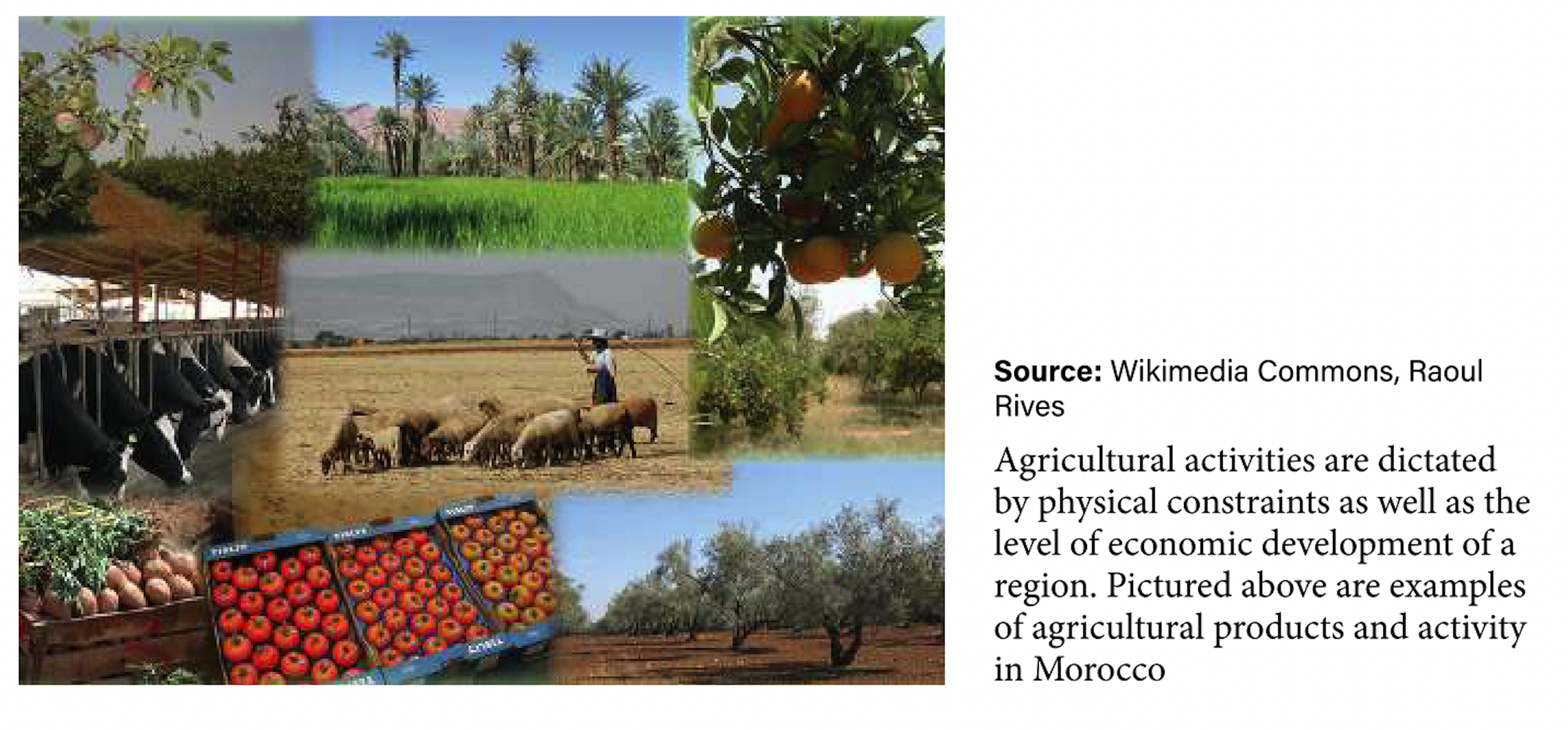
Climate and Agriculture
Despite human intervention, environmental and economic factors are often the most important influence on agriculture. They will determine what types of crops will be grown and what types of animals will be raised by farmers in many cases.
Climate Conditions and Agricultural Production
Climate always has and will continue to play a major role in determining what types of agriculture will take place throughout the world. Most of the earth’s land surface supports some type of agricultural activity. The few exceptions are those that are considered to be physically extreme. These include land at highest latitudes or highest elevations, and areas with the highest or lowest precipitation. In these areas, population density for most of human history has been low.
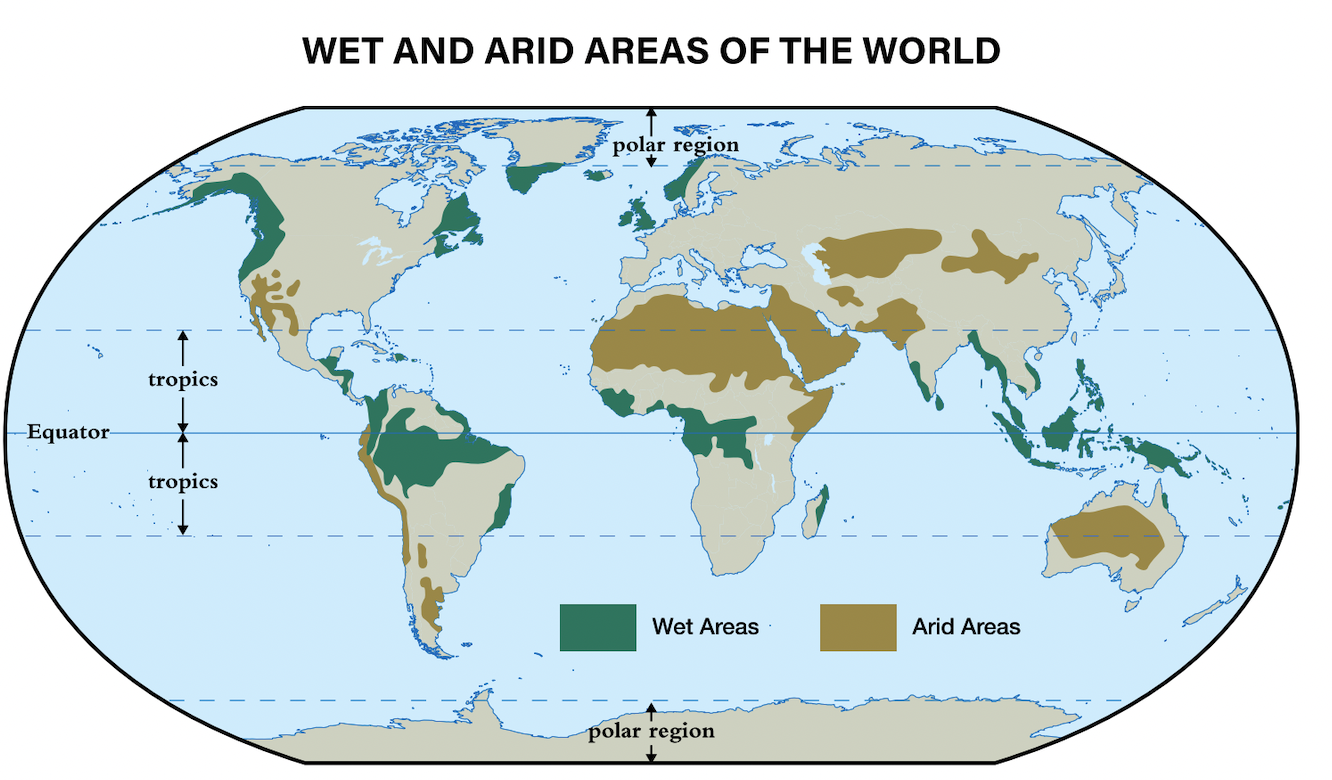
The level of development of a country and its access to modern technology can have a significant influence overcoming climatic obstacles. In the cold climates of Iceland and Greenland, farmers can grow crops in greenhouses. The tomato market, once dominated by sunny and warm U.S. states such as Florida and California, now includes the products of large Canadian indoor growing facilities.
The relationship between climate and cultural traits, such as food preferences, also shapes agricultural activity. The climate of Southwest Asia is fine for raising hogs. However, in a region dominated by Muslims and Jews, most people have religious objections to eating hogs, so farmers choose to raise other animals.
Economic Factors and Agriculture
Climate has a significant influence on agriculture, but economic factors also influence production. Many people across the world are involved in food production, but a significant difference is who consumes the food they produce.
Subsistence Agriculture
The primary goal of subsistence agriculture is to grow enough food or raise enough livestock to meet the immediate needs of the farmer and his or her family. A secondary goal is to sell or trade any surplus for income or goods. Most subsistent farmers live in less-developed regions of the world and have small farms of fewer than two acres. Limited land and the expense of advanced agricultural technologies have made it difficult for subsistent farmers to grow excess food to sell or trade.
Commercial Agriculture
The primary goal of the commercial farmer is to grow enough crops or raise enough livestock to sell for profit. It exists in all countries but is more common in developed countries. However, it has become increasingly common in semiperiphery countries, such as China, Mexico, and Brazil. To increase yields further, commercial farmers often use the profit from the sale of their products to purchase more land, equipment, and technology, or to pay for training in the newest farming techniques.
The interaction of economic factors and climate influences agricultural activities in many locations. For example, animal herding takes place in drier climates such as North Africa and parts of the United States and Canada. Animal herding practiced by pastoral nomads in North Africa is an example of subsistence agriculture. Their herds are generally smaller in size, and the milk, meat, and hides are used by the farmers and their families, rather than sold for profit. By contrast, cattle raising in the United States and Canada is commercial agriculture. Cattle roam the western prairies and feed on natural vegetation prior to being sold and slaughtered.
Intensive and Extensive Farming Practices
Another factor that influences agriculture is the amount and type of resources used to grow crops or raise animals. Intensive agricultural practices are those in which farmers or ranchers use large amounts of inputs, such as energy, fertilizers, labor, or machines, to maximize yields. Extensive agricultural practices use fewer amounts of the inputs and typically result in less yields. Every type of agriculture involves labor, resources, and capital. Consider these ideas as part of a continuum, or line, in which each agricultural activity uses resources more or less intensely than the others.
Intensive Commercial Agriculture
Heavy investments in labor and capital are used in this type of agriculture which often results in high yields and profits. Capital is the money invested in land, equipment, and machines. Intensive commercial agriculture is almost always capital intensive but can also be labor intensive. Examples include market gardening, plantations, and large scale mixed crop and livestock systems.
Intensive Subsistence Agriculture
This form of agriculture is often labor and animal intensive. For example, in rice paddies in Southeast Asia, most of the farming is performed using low-paid human labor rather than machines. The seedlings are planted by hand and during the harvesting process, laborers cut the crops and take the outer husks off to expose the grains of rice.
Extensive Commercial Agriculture
This type of farming uses low inputs of resources but has the goal of selling the product for profit. Ranching is the most common example and can be found in the western regions of the United States and Canada, Argentina, New Zealand, and Australia. Typically, the human labor required for this type of agricultural activity is extremely low.
Extensive Subsistence Agriculture
Few inputs are used in this type of agricultural activity. It is often practiced in areas that have climatic extremes such as tropical, semi-arid, or arid regions. Two examples include nomadic herding and shifting cultivation.
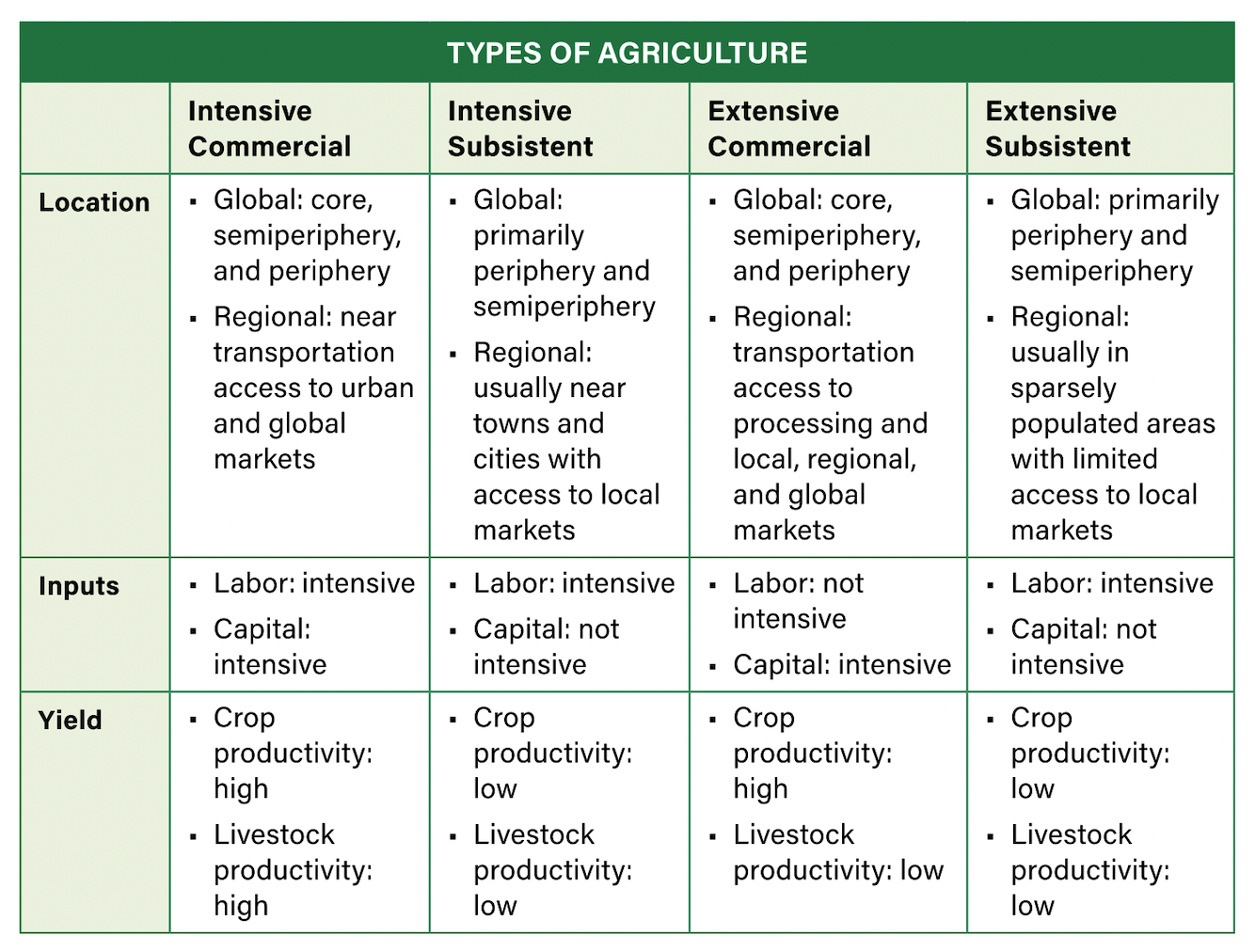
Agricultural Practices and Regions
There are a variety of agricultural practice classifications, and the regions in which they occur are strongly influenced by level of development, climate, and the purpose of the product. American geographer Derwent Whittlesey identified the eleven main agricultural regions in 1936. The following chart summarizes the types of agriculture commonly found in each climate region.
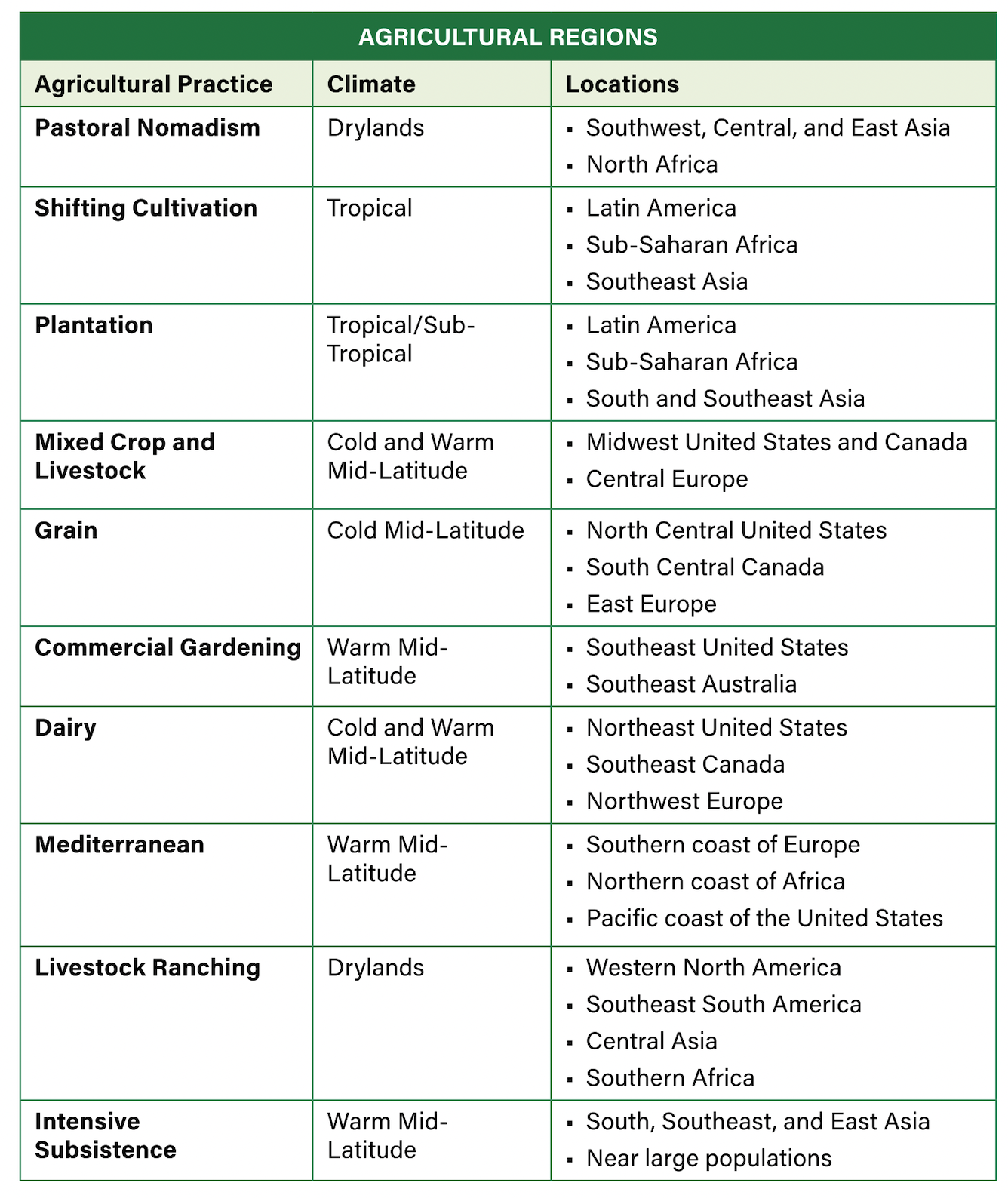
Pastoral Nomadism
This type of subsistent extensive agriculture is practiced in arid and semi-arid climates throughout the world. Nomads rely on the animals for survival. Animals such as cattle, camels, reindeer, goats, yaks, sheep, and horses provide meat for food and hides for clothing and shelter. Pastoral nomads move their herds to different pastures within their territory and often trade meat for crops with nearby subsistence farmers. Nomads in different regions rely upon different animals, depending on their culture and the climate in which they live:
- In South Central Asia and East Africa, people rely on cattle because they adapt to the hot climate.
- In desert regions of the Middle East, people rely on camels because they can survive without water for long periods.
- In Siberia, people rely on reindeer because they thrive in cold weather.
Shifting Cultivation
In this type of subsistent extensive farming, farmers grow crops on a piece of land for a year or two. When the soil loses fertility, they move to another field. Unlike crop rotation, in which farmers change the crops that are grown within a field, shifting cultivation involves using new fields.
A specific type of shifting cultivation used in tropical climate regions is known as slash-and-burn agriculture, or swidden agriculture, because farmers sometimes clear the land by burning vegetation. This process enriches nutrient-poor soil by adding nitrogen to it. On the cleared land, farmers plant and harvest crops for a few growing seasons until the soil becomes less fertile. Then, they move to another area of dense, wild vegetation and repeat the process.
Examples of shifting cultivation include growing rice in Southeast Asia, maize (corn) in South America, and millet and sorghum in Sub-Saharan Africa. Most families grow various food crops in one field for their own consumption. The community or village often owns the land used for shifting cultivation. As population increases and land becomes scarce, this practice is not sustainable.
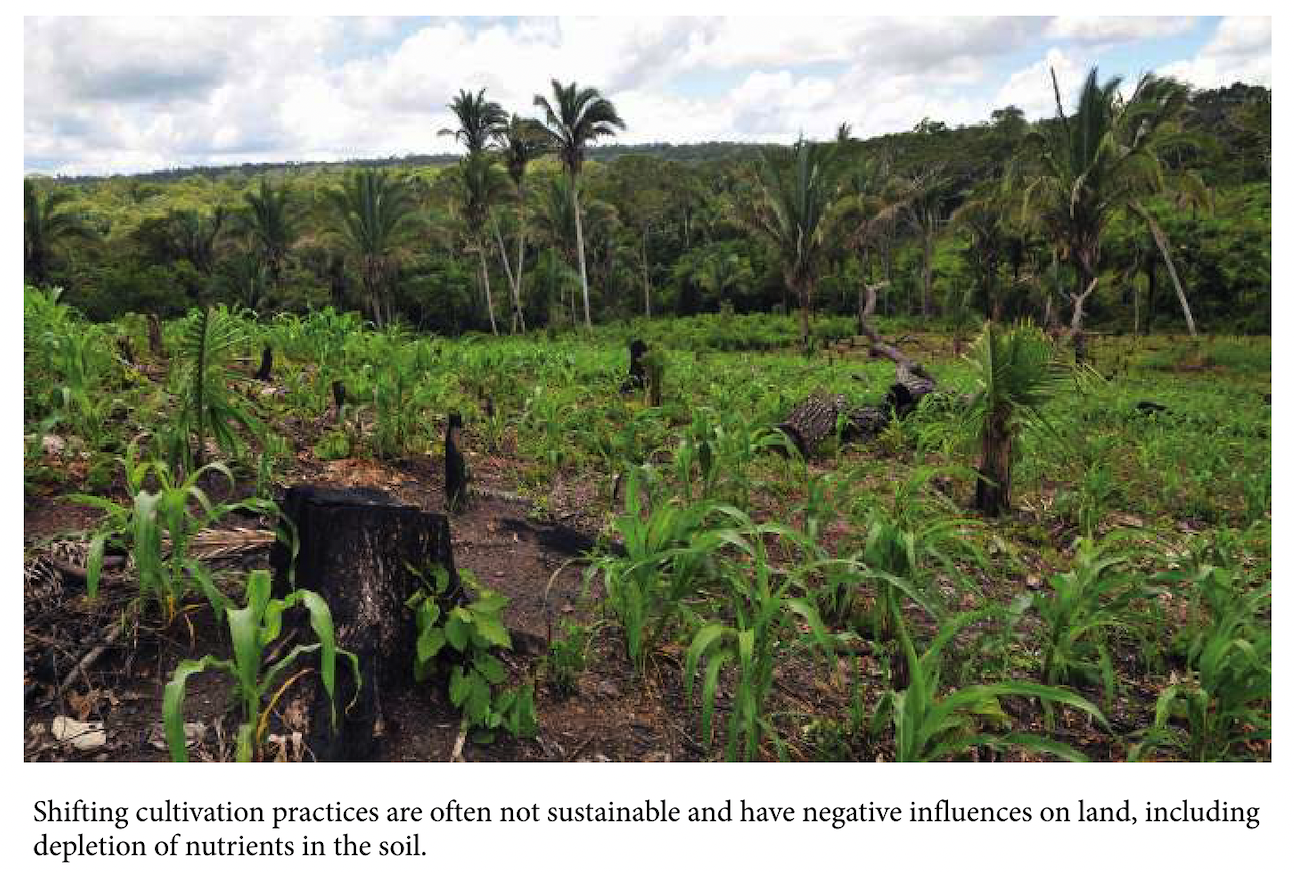
Plantation Agriculture
Under colonialism, commercial agriculture often replaced subsistence farming. A plantation is a large commercial farm that specializes in one crop. Most plantations are found in the low latitudes with hot, humid climates and substantial rainfall. They are typically labor-intensive and often exploit the low-wage labor available in nearby villages and towns.
To reduce the cost of moving bulky crops, some processing occurs near the plantation. The valuable portion of the crop is transported. Common plantation crops include coffee, cocoa, rubber, sugarcane, bananas, tobacco, tea, and cotton. As labor costs rise, plantations become more capital-intensive.
Mixed Crop and Livestock Farming
Large-scale mixed crop and livestock farming is an intensive commercial integrated system that demonstrates an interdependence between crops and animals. In some cases, one person owns the land on which the crops are grown and the cattle are raised. In other cases, the adjacent parcels of land are owned by different people—one raises crops and the other raises livestock. On these farms, the majority of the crops are grains that are eaten by the livestock—to fatten cattle for slaughter or to feed dairy cows. The animals’ manure is, in turn, used to help fertilize the crops. Mixed crop and livestock farming is common in developed regions, such as Canada, the Midwestern United States, and northern Europe, but it has diffused to parts of the developing world. U.S. farmers often grow corn and soybeans. These crops can be used as animal feed or made into various products.
Grain Farming
In regions too dry for mixed crop agriculture, farmers often raise wheat. Consumed mostly by people, wheat is produced in the prairies and plains. China, India, Russia, and the United States are the world’s top wheat producers. The type of wheat grown reflects the climate:
- Spring wheat is planted in early spring and harvested in early autumn. It is grown in colder regions such as Canada, Montana, and the Dakotas.
- Winter wheat is planted in the fall and harvested in early summer. It is grown in warmer regions such as Kansas, Oklahoma, and Europe.
Commercial Gardening
Typical fruits and vegetables grown in the United States include lettuce, broccoli, apples, oranges, and tomatoes. Large-scale commercial vegetable gardens and fruit farms are found mostly in California, Arizona, and states of the Southeast. In the winter, the United States imports these types of products from Mexico and Chile. This type of intensive farming is also referred to as truck farming because the products were traditionally driven to local urban markets and sold. Today, however, most trucks are refrigerated, which allows farmers to sell their products to distant markets.
The concept of small-scale market gardening is making a resurgence near cities with buy-local food movements. Market gardening is when fruits and vegetables are grown near an urban market and sold to local suppliers, stores, restaurants. Today’s market gardening in the United States is intensive and usually requires capital investments of greenhouses and fertilizers.
Dairy Farming
Traditionally, dairies were local farms that supplied products to customers in a small geographic area. This pattern still exists in many less-developed regions of the world. However, during the later 20th century, improvements in refrigeration and transportation expanded the milk shed, the geographic distance that milk is delivered. Large corporate dairy operations replaced smaller family-owned farms, which resulted in fewer farms but more production. Most commercial dairy farms in the United States, Canada, and other developed countries are near urban centers and transportation corridors. In a few countries, such as Argentina and Brazil, demand for dairy products increased faster than the pressure for consolidation. With economic growth and higher incomes, the number of dairy farms increased.
Mediterranean Agriculture
Mediterranean agriculture is practiced in regions with hot, dry summers, mild winters, narrow valleys, and often some irrigation. Some of these regions are southern Europe, northern Africa, southwestern Africa, southwestern Asia, southwestern Australia, California, and central Chile. Common crops grown in Mediterranean agriculture include figs, dates, olives, and grapes. Herders in these regions often practice transhumance, the seasonal herding of animals from higher elevations in the summer to lower elevations and valleys in the winter. Goats and sheep are the principal livestock because of the region’s rugged terrain.
Livestock Ranching
Livestock ranching is the commercial grazing of animals confined to a specific area. Similar to pastoral nomadism, livestock ranching is found in areas that are too dry to grow crops in large quantities. Ranching is common in the western United States; the pampas of Argentina, Brazil, and Uruguay; parts of Spain and Portugal; China; and central Australia.
